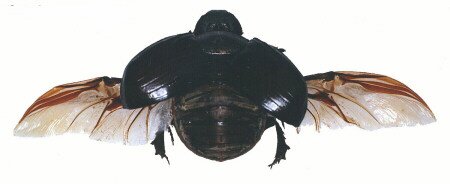|
LINKS |
GIANT DUNG BEETLEGIANT DUNG BEETLE, Heliocopris andersoni, Order Coleoptera Heliocopris andersoni is distributed from the warmer drier parts of southern Africa north-eastwards to East Africa. It is primarily associated with the coarse-fibred dung of large non-ruminant, herbivorous mammals. For breeding purposes, it buries a large amount of dung thus removing it from access to competitors. This dung mass is converted into several large, spherical brood balls in a subterranean chamber. Each brood ball contains a single egg and is coated in a clay shell. The parent beetles abandon the chamber soon after the eggs have hatched. The larvae feed on the dung, hollowing out the inside of the brood ball as they grow in size. When development is complete, they pupate and emerge as new adults in response to heavy rainfall. It is unclear whether they overwinter as immatures (third instar larvae) or as adults in southern Africa. Heliocopris andersoni may measure up to 57 mm in length and 33 mm in width. The wingspan may exceed 135 mm, and the brood balls in which the larvae develop may measure up to 103 mm in diameter. Acknowledgements: A Davis, Department of Zoology and Entomology, University of Pretoria.
|


